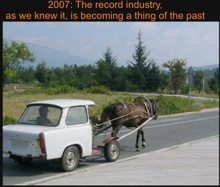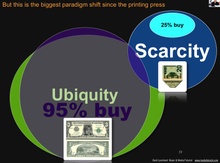
Welcome to the Club of Amsterdam Journal. We are looking back at a fabulous Season – most of our events were sold out and more importantly brought new insights, fresh thoughts and created great discussions. We had visitors from many European countries and also from Japan, China, India, South America, the States and Canada. We now have 3.700 members! We would like to thank the many helping hands and look forward to inspiring future activities. |
Felix Bopp, editor-in-chief
Open Letter to the Independent Music Industry:
Music2.0 and the Future of Music is yours – if you can resist
the temptation of becoming just another music cartel!
 | by Gerd Leonhard, Music & Media-Futurist, Author, Entrepreneur, Strategic Advisor, Visionary, Disruptor, and CEO of Sonific LLCwww.gerdleonhard.net On June 29, 2007, while at London Calling, I was invited to speak to a small group of indie record label leaders at the annual AIM / WIN gathering in London. I took this opportunity to take a good look at what needs to happen in order for the independent music companies to actually take advantage of the new music economy that is unfolding right now. So… some of my thoughts are shared below. |
Basel, Switzerland, July 1, 2007 – Today I want to present my views on what I like to call “Music2.0” – the next generation of the music industry that is being created as we speak. This new model is dramatically different: many old ways of doing things, many old relationships, and many outmoded traditions cannot and will not survive.
I want to seduce you, the leaders of the independent music industry, to go down this new road with me, to take a leap, to leave some of your assumptions and your ‘religions’ aside, and to make bold moves – because this is required to turn this ship around.
Scott Fitzgerald, the famous novelist, said: “The test of a first-rate intelligence is the ability to hold two opposed ideas in the mind at the same time, and still retain the ability to function”. This will clearly be the music industry’s challenge going forward!
Technical and economic innovations have, for the past 10 years, stripped away many traditions, social and economic hierarchies and monopolies in the music industry, and if there is one thing we can say for sure I guess that would be that it’s now show-time: the music industry is finally reaching a major inflection point; 10 years after the first .com ventures shook the ground. It took a lot longer than we all thought but it’s hitting much harder now: CD sales are down between 20 – 40% YTD, and digital sales are not making up the difference, any time soon – and the one-horse race with iTunes clearly is a dead-end.
We are very quickly nearing a point to where we are forced to dive into what I like to call “Music2.0” – a new ecosystem that is not based on music as a product, but music as a service: first selling access, and only then selling copies. An ecosystem based on ubiquity of music, not scarcity. An ecosystem based on mutual trust, not fear.
As Don Tapscott says, in his great book “Wikinomics” , we can think of Web1.0 – the ‘old’ web – as some sort of digital newspaper, while Web2.0 is a canvas that allows information to be put up, shared, changed, and remixed. It’s about the interaction, the send-and-receive options that make it useful and ‘special’. And in music, it’s always been about interaction, about sharing, about engaging – not Sell-Sell-Sell right from the start.
Stop the sharing and you kill the music business – it’s that simple. When the fan / user / listener stops engaging with the music it’s all over. Today, you urgently need a canvas for music not a one-way product (such as the CD).
Let’s face it: most ‘leaders’ of the major record companies as well as some independents are, by and large, still in denial about the fact that their unit-sales-based model is utterly broken and crashing quicker than they can fathom, and many still hope for some magical technology solution to solve a business problem.
Billions of $$ have already been lost due to misguided strategies, outdated policies, and lack of true leadership. Forgive me, but it’s time to get your act together and do whatever it takes, not just what fits comfortably into your current landscape – this is a make-it or break-it moment.

How come many societies and PROs / MROs are still at a total loss when it’s about ‘licensing the un-licensable’ (as my dear friend and colleague Jim Griffin puts it)? 1000s of companies with innovative business models are left unlicensed, by default (or shall I say by design?), and most of them have given up on even trying. Major money is left on the table due to tardiness and internal squabbling. Many of the traditional music licensing organizations have utterly failed in their mission of making music available – in fact, they have, by non-action, succeeded to make it unavailable. What you need now is action not continued excuses.
Today, we have the paradox situation that any startup that wants to use music will not even try to go legal right from the beginning, since there is no reasonable way of doing so. Look at the biggest exits in this turf, during the past 2 years: myspace, youtube, last.fm – either they did not bother with proper music licenses, or it was unclear if and where and when they would even need one. Non-compliance succeeded and was handsomely rewarded.
The music industry must admit that it has failed to act. Their leaders’ clueless-ness, incomprehension and general lack of willingness to embrace true change allowed the paying for music to become voluntary. Congrats.
Don Tapscott points at the year 2006: the losers built digital music stores, and the winners built vibrant communities based on music. The losers built walled gardens while the winners built public squares. The losers were busy guarding their intellectual property while the winners were busy getting everyone’s attention. Warner Music Group’s stock nose-dived from $30 to $14 in less than one year; Google rose from $323 to $526, Apple went from $50 to $127.
For the independent music industry, the question is: which side do you want to be on? Do you want to become another ‘major player’, and stay stuck in music1.0, or do you want to lead the way into music2.0?
In this context please allow me give you a glimpse of the future, so that you can make some decisions based on what is coming.
1. Within 18 months, in many key music territories around the globe, wireless broadband networks and device-to-device ad-hoc networks will connect every conceivable device with each other, as well as with gigantic online content depositories – or shall I say switch-boards – that will contain every imaginable song, film, or TV show.
If you think ‘sharing’ is a big deal now, wait another 2 years – it will be 100x as fast and enabled on every single device (not just computers). 3 Billion+ cell phones and 1 Billion+ music players will connect seamlessly to each other.
Wireless broadband access and devices will become so cheap, super-fast and ubiquitous that sharing content will become the default setting, at very high speeds and with anyone that is close by. Search – Find – Select – Exchange. Click and get.
How can you monetize this? By licensing participation – and the networks and the devices that enable it. You must license the use of any and all music on these networks, and make irresistible, irrefutable and compelling blanket offers to those that run it. These license deals must be conversations not monologs. Not a stick to the ISPs but a huge, shining and attractive carrot.
2. 10s of 1000s of new TV, online video, and gaming channels will be born in the next 2-3 years – and all of them will need music to go with the visuals. Millions of songs will be synched to video – this market will positively explode. It may well be that those B2B licensing revenues end up being more than 50% of your future income.
However, exploiting these opportunities will only be possible if an efficient and frictionless system for transactions is available – this is, imho, where the huge opportunity for the Merlin initiative (where AIM is a member) lies. Think ebay+ chemdex +ricall + pumpaudio+. Every $ invested in better B2B processes will make 10s of 1000s for music rights holders… while they sleep, or better yet, make more music.

3. Streaming music, on demand, will be everywhere. On every website, every widget, every mobile, every device – supported by ads, sponsorships and commissions on transactions. Performance-based income will surge beyond your wildest imaginations, But again, only if you finally chose to play ball, to participate, to make irresistible license and rate offerings, create reliable standards and go flat-out for liquidity not try to maintain artificial scarcity. BMI’s revenues have grown from $630 Million in 2003 to $779 Million in 2006 – not bad considering the overall demise of the recorded music market, at the same time! So read my mouse: It’s not the copy of the recording that makes all the $$$, it’s the use. In fact, the use of your music is the next big format you have been looking for.
4. Rich media (i.e. ads with music, video, animations, audio etc) will become the default advertising format for online advertising, representing yet another huge growth opportunity for music. Soon, 10%+ of all ad-spending will be on the Internet; and 16% of all Internet ads in 2009 will be rich media. With an estimated $ 700 Billion of global ad spending by 2009, that means $70 Billion for online ads, and over $10 Billion spend for rich media ads. 100s of millions of $$$ for music licenses!
5. Digital radio will deliver 100% time- and place shifted music experiences, stopping only a tiny bit short of becoming another iTunes. The reality is that net radio is just another Tivo for music. Radio will indeed become the feels-like-free, on-demand music box, once again: the only remaining ‘Radio1.0’ factor will be that it will continue to be curated and expert-produced, as well as taking in social recommendation and smart technology agents. The best radio stations will become very strong brands (Radio 1, KCRW etc), out-doing what used to be record labels. How will you license Radio2.0 if you insist on staying with a per-copy model?
6. All music companies will become video companies, too – music will be multimedia, by default (music + video + audio + text + games). If you aren’t already diversifying into video and TV you really should.
7. China, India, South America and Africa will explode with new models of usage rights – bundles and flat rates based on access. And guess what: they will indeed have those $100 computers that Negroponte is trying to bring to them!
But again, you will not have truly liquid (i.e. efficient, low-friction, vastly scalable) markets until you allow, support, and enable them. You must swing this ship around, because right now, the music industry is failing miserably: failing on technical and on licensing standards, on flexible pricing offerings, on competitiveness, on compatibility, on being trusted, on transparency.
The music industry’s past was based on:
• Control
• Exclusivity
• Monopoly
• Closed-ness
• Guarding / Protection
• Secrecy / Non-Transparency
• Territoriality
Your future – if you chose to go there – is based on:
• Openness
• Total transparency
• Peering
• Sharing
• A truly global outlook
• Liquidity
I predict that as much as 60% of this new music business – and with that I mean a $100 Billion music business – will be independent within 3-5 years – but only if their leaders don’t follow the major labels into LIKING CONTROL MORE THAN INCOME.
Here are a few of my favorite bottom lines:
1) The media ecosystem of the future is frictionless. That means music anytime, anyhow and anywhere, ranging from free and ‘feels like free’ to bundled, up-sold and premium’ed. Your job as a music company is to do away with the friction, not to add to it, or even to re-insert it: on the Internet, every hurdle is treated as damage, and the traffic is simply routed around it. Create friction and be side-stepped.
2) It’s all about participation not prevention. Because of the utter impossibility of maintaining any real hurdles, it is absolutely crucial that you find ways to participate in any and all forms of commerce that use music. Charge smartly for access but make music available the same way that cell phone operators make cell phones available: a very low-cost, irresistible way of engaging people… and sell-up from there. Whether it’s streaming on demand, remixes and mashups, play-listing and social network music applications, to add-music-to-video, to digital radio – being part of it is what it’s all about.
3) Let’s face it: the web is like a giant Tivo, a huge recorder or DVR – all performances are or can be recorded, all broadcasts really are deliveries. You need to stop distinguishing between music ‘to keep / own’ and music ‘to listen to’ – our users have done this a long time ago! License the USE. Share revenues. THEN upsell to ownership.
4) Copyright is the principle, usage right is where you monetize. Usage is where you need to focus your energies, not the ‘protection of Intellectual Property’. This is a tough spot but again… do you want total control, or do you want revenues?
5) Very few things end completely when new inventions are taking hold – usually, the market just grows larger. And it will be no different here. Yes, the fax machine and the Internet killed the Telex and telegraph, but we still have books even though we have Xerox machines. CDs will decline, and may fade out completely, eventually, but nothing you do in digital music will completely wipe out physical media. This is just another format, and it’s called ACCESS. And even better: after you provide access, you can sell ownership again, too (think HD!)
6) Remember that the only real limit to growth, in music and in media, is TIME. Media consumption will rise and rise and rise, as the offerings become cheaper and more ubiquitous, and as more of the “Digital Natives” consume multiple media at the same time. You are now engaged in a battle for the wallet and the clock – but the clock comes first. Mind share means time-spend means money spend! Again, this is where attention translates into money, and this is why the first objective is to get attention, and only then to get money. The biggest problem for most artists (and their labels) is obscurity not piracy!
7) Engage not enrage: stop anything that enrages the users. And do it now.
8) Guess what: you can compete with free because what you can offer is not free. Yes, a copy of a file is free. A CD burned from another CD is free, a USB stick’s content copied to my computer is free. But the real-life connection to the artist, the experience that is happening around the music, the added values such as videos, films, games, chats, books, concerts and merchandising, the context (!!!) – all of that must not be free. You must stop the obsession with trying to make money merely from selling copies, and instead provide access, because only the legitimate and authorized source (i.e. agent-label-manager) can provide the whole bundle of values that the users, fans, the people formerly known as consumers, will buy.
Music2.0 is an unprecedented opportunity, very much like when music when from acoustic to electric. Everyone wants music. More music is used on more platforms, all the time. An unprecedented hunger for music that you need to fulfill!
Finally, here are some challenges that I believe a music industry led by Independents must embrace.
1) Once released, a recording becomes, in reality, available by default and must be made ‘usable’ under a default license – all else equals tacitly conceding that it’s free to use without permission. As a result of such a new ‘default license’, some rights principles that we have gotten used to probably won’t translate in this environment – such as the moral right of deciding where you music is being performed or maybe even otherwise used. However, I don’t think this will apply to commercial use in films or ads – unlike the private or semi-private use in UGC and web-generated content, and of course, to public performance.
2) The traditional definition of ‘copyright’ and ‘intellectual property’ can, for the time being, not be the sole key to monetizing your creations. Because it is no longer about copies, it’s no longer about the right to copy, it’s no longer about reproduction – it’s about how music is being used and how to participate in those much larger revenues.
Call it ephemeral copies, tethered downloads, rented media, streaming, buffering, caching, storing, time-shifting, downloading, ripping or whatever – the fact is that digital technology has done away with the distinction of a so-called performance being different than a so-called DPD (digital phonographic delivery). All computers – and that means all cell phones, too ! – are by definition copying machines. As overwhelming as this may sound, you must therefore discard the idea of charging more to ‘keep’ music, as opposed to just ‘listening’ to it as in radio. Instead, you must focus on charging for added values (such as a better way to keep the music ;), and on collecting revenue at every point of access, and then go from there. I don’t want to get into my good old ‘music like water’ rant again, but charge for music like utility companies charge for basic water & electricity service, and then charge more for all the other options. The bottled water business is a $100 Billion industry!
3) Your revenues from selling ‘copies of songs’ will soon dwindle down to maybe 30% of your total income – the rest will be revenues from licensing, sync, performance, bundling, flat rates… revenue sharing and the many other streams that are yet in their embryonic stages. Get busy creating and supporting those new revenue streams!
4) You can’t afford exclusive rights representation at high rates any longer, unless these institutions give you 100% coverage and a flawless solution.
5) Forget territories except for when serving local repertoire (which is on the rise, too). Most talent is global, and your audience is global, or at least virtually local. Internationalize right from the start and build systems that will support that. Build a worldwide licensing and B2B-transactions system that makes all repertoire available for all types of use, and build it quickly.
6) Resist the temptation to do as the major labels have done (e.g. extract huge one-off payments, extort equity shares, license at unreasonable rates, refuse access for no reason but for market control concerns, sue their own customers etc) – that is a certain death wish. In fact, now you can force them to follow you!
7) Resist all attempts at locked / protected formats, and go for open systems.
8) Bundle and package music in new ways: with other services, with other products. And prepare for the Flat Rate because this is certainly coming.
9) Remove any and all hurdles to complete market liquidity: pricing inflexibility, lack of standards (technology), lack of licensing transparency, territorial differences, monopolies.
10) Embrace outsiders to jumpstart the music business. Niklas Zennstrom disrupted the telecom business, Hotmail changed email, Stanford dropouts started Google – the innovation often comes from the outside.
Call me a Utopian, call me a Dreamer, call me a ruthless Optimist, but I think this is the Future of Music.
Taste of Diversity Impressions
Taste of Diversity
Impressions

Club of Amsterdam blog
 | Club of Amsterdam blog http://clubofamsterdam.blogspot.com June 4: Universal Declaration of Human Values April 20: Aspects of Mobility |
News about the Future

The Economist Intelligence Unit, in conjunction with an international team of academics and peace experts, has compiled an innovative new Global Peace Index (GPI), which ranks 121 nations according to their relative peacefulness. The Global Peace Index is composed of 24 indicators, ranging from a nation’s level of military expenditure to its relations with neighbouring countries and the level of respect for human rights. The index has been tested against a range of potential “drivers” or determinants of peace – including levels of democracy and transparency, education and material wellbeing. The team has used the latest available figures (mainly 2004-06) from a wide range of respected sources, including the International Institute of Strategic Studies, The World Bank, various UN offices and Peace Institutes and the Economist Intelligence Unit. The Global Peace Index is intended to contribute significantly to the public debate on peace.
A number of Nobel laureates, including Joseph Stiglitz, backed the study which named Norway and New Zealand as most peaceful and Iraq and Sudan as the least


Some things you’ll find in the report:
Eight Developments in Media July 06 of June 07. Examples of key developments, including industry transactions and acquisitions, layoffs, new channels, intellectual property, and consorship.
Shifting Global Advertising Channels. Data and commentary on shifts in advertising spending, and a comparison of ownership of the online classifieds segment in the US, UK, and Australia.
Comparison of Fastest Growing Properties and Internet Access. Exclusive original research from Nielsen//NetRatings, comparing uptake of new media properties in the US, UK, and Australia, and different online browsing behaviors across nations.
Key Elements of Media Business Models. Following the extremely popular Future of Media Strategic Framework from last year, we have created four complementary frameworks looking at Scalability, Value of Distribution, Value of Advertising, and Media Personalization. These can be applied to understanding emerging media business models. Each of the frameworks is explained in detail.
Media Industry Network Analysis. An analysis by Laurie Lock Lee of the recent acquisition of Southern Broadcasting Corporation by Macquarie Media Group, and insights on the impact on the Australian media industry landscape.
Media Transactions. A list of media mergers and acquisitions of at least US$1 billion over the last 15 years, putting the massive surge in recent media industry activity into context.
The BioSUB Project
| Having won the Australian Geographic “Live your dream” Wildest Adventure Competition for its exciting mix of education, science and adventure, the BioSUB Project saw Australian marine scientist and diver Lloyd Godson survive in the world’s first attempt of a self-sufficient, self-sustaining underwater habitat. The BioSUB Project compared life underwater to life inside a closed ecological system. It required the same specially-designed regenerative or recycling technology needed for any long-term manned mission to Mars. Lloyd had to generate oxygen, grow food, obtain fresh water and deal with his waste. In order of importance Lloyd needed air, water and food. Of course, to live underwater he also needed power to generate light and heat in the form of electricity generated by the sun.Lloyd sees these future implications from his BioSUB projectnew technologies are overcoming existing barriers to humans leaving the dry land for a permanent life in the oceanusing algae as a way of reducing greenhouse gas emissions such as CO2if one young man can survive in a recycled shipping container, then undersea colonies are on the way!if we do eventually colonise the oceans, let’s do it in a sustainable and environmentally friendly wayhopefully more people will live their dreams and explore the oceans as a result of the BioSUB project…because life is an adventure! |




OLYMPUS DIGITAL CAMERA 
Recommended Book

Brave New Interfaces
by David Matsumoto, Linda Juang
CROSSTALKS is the industry and university network of the Vrije Universiteit Brussel (VUB). Launched in 2003, it acts as an open and interdisciplinary platform to discuss policy-probing issues. CROSSTALKS manifests itself by interweaving practices from various scientific disciplines, different innovative companies and the art world.
For this book we gathered key people from the European design, architectural, art and academic and corporate technology-driven worlds to reflect on the meaning and impact of existing and future interfaces – and on what the added value could be. The topic of exploring existing and future interfaces and their design emerged from numerous discussions on whether spectacular technological innovations also meant or implied something more than just technological progress. Depending on the gender and the technological literacy of the conversationalists, the answer might be yes, no, or somewhere in between.
Brazil: Sustainable Electricity Agenda 2020
 | Brazil: Sustainable Electricity Agenda 2020 To ensure Brazil continues to play a positive role in this area, WWF-Brazil, in cooperation with a coalition of associations of clean energy producers and dealers, environmental groups, and consumers, commissioned a survey to researchers from Unicamp (State University of Campinas) and the International Energy Initiative.The result of this survey is presented in this report, which makes an ambitious – though realistic – analysis of Brazil’s energy potential in order to fulfill the country’s power requirements by 2020 with fewer impacts and lower carbon emissions. This study is part of an international initiative called ‘PowerSwitch!’, which is being implemented by the WWF network in over 16 countries. | |
Executive Summary
The purpose of this study is to describe a scenario for the Brazilian electricity sector until 2020 that helps achieve various political objectives, including increased security of electricity supply; develop technological innovations; drive downs costs to end consumers; create jobs; and minimize socio-environmental impacts. This sustainability scenario can be achieved through aggressive energy planning policies aimed at improving power efficiency and increasing use of renewable sources to generate electricity. The authors call this a Sustainable Energy or PowerSwitch! Scenario. As a reference, another scenario was developed – the Business as Usual Scenario – in which the future development of the electric sector reflects official forecasts available in the country.
The PowerSwitch! Scenario shows the potential efficiency increase in the electric sector and the possibility of doubling the share of renewable sources (biomass, wind energy, Small Hydroelectric Plants [SHPs], solar thermal and photovoltaic energy), compared to the Business as Usual Scenario, where the former scenario makes it possible to cut energy costs by about 40% by 2020. This is possible by combining efforts to reduce consumption and foster wise use of electricity and by introducing and expanding renewable sources that replace fossil sources to generate electric power. Enhanced energy efficiency, especially on the demand side, is a key strategy to save resources, replace fossil sources and stop building large hydroelectric plants.
The PowerSwitch! Scenario reduces the need for expansion of the installed electricity generation capacity. While the Business as Usual Scenario requires 204,000 megawatts (MW) of installed capacity (for an annual growth rate of about 5% from 2004 to 2020), the PowerSwitch! Scenario requires total capacity of 126,000 MW (an annual growth rate of 2% for the same period). Estimated savings represent 293 TWh of spared electricity by 2020, i.e., about 75% of total consumption in 2004. Fossil fuel fired generation accounted for 19% of the country’s installed capacity in 2004, and it reaches 24% of capacity by 2020 under the Business as Usual Scenario. However, under the PowerSwitch! Scenario a 14% reduction of the estimated total installed capacity is possible.
And the PowerSwitch! Scenario does not need to be more costly than the Business as Usual Scenario. Even considering additional expenses to increase the share of renewable sources (which even in 2020 are assumed to be more expensive than conventional sources), the PowerSwitch! Scenario provides savings of 12% in the costs of delivering energy services through energy efficiency measures. This accounts for about R$ 33 billion in savings in the year 2020 to generate, transmit and distribute electricity across the country.
By reducing energy wastage and increasing the share of renewable sources, this scenario will prevent an additional 78 thousand MW from being installed in the national electrical system. This would correspond to approximately 60 Angra III plants, 14 Belo Monte plants, or six Itaipu plants, or seven times the installed capacity planned under the Ten-Year Expansion Plan for 2006-2015 for the Amazon region. As a result, potential socio-environmental conflicts associated with expansion of hydroelectricity in the Amazon will be reduced.
In addition, there are major benefits from the PowerSwitch! Scenario in terms of job creation, biodiversity conservation, and emissions reductions. Considering the opportunities for increased use of renewable sources alone, an estimated four million new direct and indirect jobs may be added to the jobs already associated with the Business as Usual Scenario, thus totalling 8 million new jobs created under the PowerSwitch! Scenario. This figure does not include new jobs that will
certainly emerge through larger investments in energy efficiency, whether direct or indirect jobs.
The reduced hydroelectric expansion under the PowerSwitch! Scenario means less area is required for new reservoirs, which reduces impacts on biodiversity. Although calculations of flooded areas are extremely dependent on the geographical location and size of projects, we estimate that the expansion associated to the PowerSwitch! Scenario implies a flooded area that is seven times smaller than that required by the installed capacity of hydroelectric plants and SHPs under the Business as Usual Scenario.
Carbon dioxide (CO2) emissions level off at around 20 million tons. Nitrogen oxide (NOx) emissions could be reduced from 7 million tons in 2004 to 5.5 million tons by 2020 under the PowerSwitch! Scenario, but they could hit 17 million tons by 2020 under the Business as Usual Scenario. If carbon credits obtained through the PowerSwitch! Scenario were traded at an estimated international cost of 32 euros per ton of CO2 by 2020, a credit of R$ 5.6 billion would still be available by 2020 (i.e., 2% of total costs under the PowerSwitch! Scenario). If we consider cumulative emissions for the 2004-2020 period, a total of 413 million tons of CO2 are avoided under the Sustainable Energy Scenario, thus exceeding the emission of 403 million tons of CO2 through the Proálcool Program in the 1975-2000 period. Such reductions could result in R$ 47.5 billion in cumulative revenues throughout this period through selling credits on the carbon market.
In order to implement the PowerSwitch! Scenario, the government must approve and deploy a more efficient and innovative strategic plan for the electric sector so as to foster effective implementation of energy efficiency measures, as well as expanded use of renewable sources. This plan should include the following nine measures:
1. Energy Effieciency Auctions
Energy efficiency auctions must be held. This is an alternative way of enabling implementation of energy-saving measures on the supply and end-use sides through market agents. For end-use measures, this will make it possible to establish energy efficiency services companies and, with regard to the supply side, it will boost rehabilitation of old hydroelectric plants through repowering. These efficiency measures will deliver a potential of about 290 TWh by 2020. In addition, auctions may attract market agents to handle at least 15% of this potential.
2. Energy Effieciency Standards
The Energy Efficiency Law must be implemented urgently by quickly approving energy performance standards for equipment which ensure substantially reduced consumption. To complement performance standards for equipment, more efficient technologies and processes can be developed throughout the supply chain. Hence, the government must approve energy efficiency levels for all links in the supply chain, focusing on energy-intensive sectors and starting by the most inefficient segments with the largest potential for reductions. Compliance with standards can be achieved first through incentives, then with fines or penalties if the level is not reached. In addition, mandatory technical standards and use of Research & Development funds must be
part of policies to reduce technical transmission and distribution costs.
3. Technology Bids
The public sector accounts for approximately 10% of total electricity consumption. Government agencies can set performance standards that will encourage manufacturers to develop and supply a given product to satisfy this demand. This sort of initiative is particularly important when linked with new technologies that have not yet been introduced at a significant scale into the market.
4. Efficiency Investment Targets
Mandatory investments by electrical utilities in energy efficiency and Research & Development programs, along with better management of the Sectoral Energy Fund (CTEnerg) estimated at about R$ 400 million/year, is needed to to ensure maximization of social benefits. Therefore, it is necessary to establish targets for outcomes of investments in energy efficiency, improve capabilities for monitoring, checking and evaluating the outcomes in terms of conserved MWh and avoided MW that are obtained from these resources.
5. National Distributed Generation Program (PROGEDIS)
The government must implement a distributed generation program at the national level that includes stable and transparent incentives which make it possible to tap into the potential provided by these technologies. Considering the large co-generation potential from sugarcane, valuation criteria and methods for auctions of new generation capacity must be part of the preliminary public hearing processes.
6. Incentive Program for Alternative Electric Energy Sources – Phase II (PROINFA II)
The purpose of announcing and implementing PROINFA’s phase two is to ensure 10% of electricity production from renewable sources by 2010, and 20% by 2020. A more transparent program that involves less red tape and is adapted to the needs of renewable energy producers would be a substantial gain during the second phase. It is essential to ensure economic incentives for this program, along with the National Distributed Generation Program, where a part of the funds saved through avoided generation of electricity could be allocated through Energy Efficiency Programs to avoid passing price increases on to consumers.
7. National Solar Thermal Energy Program (PROSOLTER)
In order to effectively tap into the huge potential of solar thermal energy in Brazil, a national program for this clean and cheap source of energy is required. This programme must include development targets, financing incentives for end consumers, and tax breaks. Low-income populations should receive substantial benefits from such measures. Appropriately designed systems must be installed in new buildings. About 9% of total energy savings under the Sustainable Energy Scenario derive from implementation of a national program covering nearly a third of households across the country by 2020.
8. Reduction of Subsidies to Conventional Sources of Energy
Subsidies to fossil fuels encourage electricity waste and make it difficult to introduce renewable sources of energy into the country’s electrical matrix. It is necessary to reduce and eventually phase out such subsidies, such as the Fuel Consumption Account (CCC in Portuguese), which introduces biases into the market favouring fossil fuels such as coal and diesel. However, application of CCC funds must clearly distinguish between approaches to the integrated grid and isolated systems. For 2006, over R$ 4.5 billion will be spent with CCC, which is 10 times more than the amount of mandatory investments to be made by electricity companies under energy efficiency programs.
9. Ongoing Dissemination of Information
Although the country has developed awareness programs, through the National Electricity Conservation Programme (PROCEL), the National Program for the Rational Use of Petroleum Products and Natural Gas (CONPET) or the energy companies themselves, it is constantly necessary to follow up with dissemination of up-to-date information on energy technologies and the most efficient ways of using them. Significant barriers still exist, especially in terms of dissemination of technologies for thermal uses of solar energy in the household, industrial and office building sectors.
Vertical Gardens
| Patrick Blanc’s vertical gardens Marché des Halles in Avignon  Musée du Quai Branly, Paris  l’Hôtel Pershing Hall, Paris    |
Agenda

| Our program starts again in September |
Club of Amsterdam Open Business Club
 | Club of Amsterdam Open Business Club Are you interested in networking, sharing visions, ideas about your future, the future of your industry, society, discussing issues, which are relevant for yourself as well as for the ‘global’ community? The future starts now – join our online platform … |






Customer Reviews
Thanks for submitting your comment!